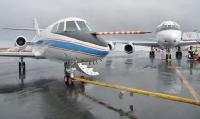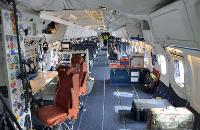Фотографии
-
Регистрационный номер: N817NA [11] The DC-8’s JT3D turbofans were replaced by these CFM56s in 1986 following its acquisition by NASA.
Самолёты на фотографии: Douglas DC-8 - США - 1958
-
Регистрационный номер: N817NA [11] Some 100 small tube-shaped dropsondes were dispensed in-flight during the Iceland mission to obtain vertical wind profiles and transmit information on air temperature and moisture.
Самолёты на фотографии: Douglas DC-8 - США - 1958
-
Регистрационный номер: N817NA [11] NASA DC-8-72 (N817NA) at Keflavik, Iceland, in May 2015 for the polar winds research flights.
Самолёты на фотографии: Douglas DC-8 - США - 1958
-
Регистрационный номер: N817NA [11] After being dropped through the fuselage from around 19,000ft (5,800m), the dropsondes transmit data for up to 12 minutes.
Самолёты на фотографии: Douglas DC-8 - США - 1958
-
Регистрационный номер: N817NA [11] Some scientific instrumentation is loaded onto the aircraft by using openings in the outer skin or replacing windows with plugs containing sensors.
Самолёты на фотографии: Douglas DC-8 - США - 1958
-
Регистрационный номер: N817NA [11] The DC-8-72 worked alongside the German Aerospace Center's Falcon for the polar winds research flights.
Самолёты на фотографии: Dassault Falcon 20 / 30 - Франция - 1963Douglas DC-8 - США - 1958
-
Регистрационный номер: N817NA [11] Wing-mounted sensors.
Самолёты на фотографии: Douglas DC-8 - США - 1958
-
Регистрационный номер: N817NA [11] NASA DC-8-72 N817NA at Keflavik, Iceland, in May 2015 for the polar winds research flights.
Самолёты на фотографии: Douglas DC-8 - США - 1958
-
Регистрационный номер: N817NA [11] Two or three scientists are allocated to each experiment aboard - and close co-ordination is required with the flight crew to plan flight operations that are both safe and meet scientists’ requirements.
Самолёты на фотографии: Douglas DC-8 - США - 1958
-
Регистрационный номер: N817NA [11] Despite its age and analogue cockpit, NASA research pilot Wayne Ringelberg praised the DC-8-72's solidity and performance.
Самолёты на фотографии: Douglas DC-8 - США - 1958
-
Регистрационный номер: N817NA [11] Around 25 people can be carried in the very spacious cabin, where wide vintage first class seats are surrounded by equipment racks.
Самолёты на фотографии: Douglas DC-8 - США - 1958
Статьи
- -
- News
- A.Drwiega - Camcopter to the Rescue /Technology/
- A.Mladenov - Still Going Strong /Military/
- A.Mladenov - Workhorse Soldiers On /Commercial/
- A.Spaeth - The Last of its Kind /Commercial/
- D.Unwin - An Austrian Gem /Commercial/
- H.-P.Grolleau - 'Transallito' /Military/
- M.Broadbent - Improving the Flow /Technology/
- N.Pittaway - Introducing Growler /Military/
- P.Butowski - Katran & Helix /Military/
- P.Butowski - Russian Fighter Showcase /Military/
- R.Niccoli - Changing Times /Military/
- R.Niccoli - Turkey's F-16s /Military/
- R.Yanez, A.Rodriguez - Patas Negras /Military/
- S.Santana - Perfecting a Striker /Military/










